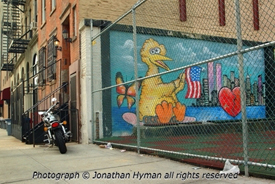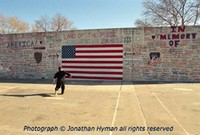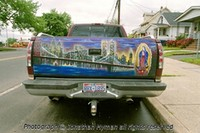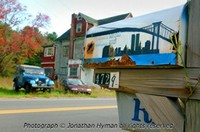Photographer’s post-9/11 images highlight ‘vernacular memorials’ in decade after attacks

Americans began a visual conversation with each other in the days and weeks after 9/11, and Rutgers alumnus Jonathan Hyman has been listening with his camera ever since.
Billboards, barns, and tattooed human bodies – all are grist for Hyman’s lens. An estimated 20,000 photographs in all, the images document the intersection of private grief and public expression in the post-attack decade.
Now 60 of these photos have been gathered at the Sylvia Wald and Po Kim Art Gallery in Manhattan for a one-man exhibition “9/11: Visual Response on the Street.” Running through October 8, the installation captures what the artist calls the “vernacular memorials” – hurt and hurting people, some of them angry, many of them spontaneous, all of them grassroots, in the metaphorical shadow of the fallen towers.
“Since September 11, 2001, I have been traveling the country with my camera every day,” says Hyman, who graduated from Rutgers as an art major in 1982. “My goal is not just to take the pictures, but also to contextualize the vocabulary people are using.”

That vocabulary includes American flags wrapped around the thin trunks of birch trees, and the backs of firefighters inked with the names of fallen comrades. It finds its voice in murals painted on the sides of farmhouses and the rooftops of split levels, and in graffiti scrawled on abandoned buildings.
“I began to see this on the very day of the attack, when I went to pick up my daughter from preschool,” Hyman says. “I noticed signs by the side of the road: ‘We will prevail.’ Or ‘It’s time to kick some ass,’ or just flags that people had left.”
The sight moved him profoundly.
In an essay in the Journal of American History, the Bethel, New York, resident notes that since then, he has devoted himself to “recording the heartfelt and idiosyncratic ways people have been making memorials to display their sorrow, patriotism, anger, and in some cases, wishes for peace, unity, war, or revenge.”Hyman has had a longstanding relationship with Rutgers. Over the years, he has served as a guest lecturer, and in 2006 he was a visiting artist in the Department of American Studies. He has also spoken at the Edward J. Bloustein School of Planning and Public Policy.

But the roots run even deeper. His father, Ronald Hyman, arrived at Rutgers in 1966 as a professor in the Graduate School of Education, and his mother, Suzanne Hyman, was a founding editor of the Raritan Review, a literary journal based at Rutgers. The photographer jokes that he’s known since third grade that his future was “on the banks.”
When it came time to prepare for possible exhibits commemorating the 10th anniversary of the attacks, Hyman reached out to fellow alum Jeffrey Wechsler, with whom he has kept in touch since his undergraduate days.
A curator for 34 years at the Jane Voorhees Zimmerli Art Museum on the New Brunswick Campus, Wechsler received his master’s in art from Rutgers in 1977. He says he finds great energy and photographic artistry in Hyman’s work.
“While the imagery is documentary in essence, the aesthetic qualities are evident. Jonathan is careful to include surrounding structures, objects, and instances of human reaction to offer a deeper and experiential context to the main subjects,” Wechsler says.
Hyman travels widely to speak about his work at universities and colleges in the United States. He toured Europe in 2008 as a State Department cultural envoy under the auspices of the American Embassy in Vienna, lecturing at universities in Austria, Germany, the Czech Republic, and Croatia.
He has exhibited his photographs at well known museums and libraries, including the National Constitution Center in Philadelphia . On the fifth anniversary of the attacks, he had a solo exhibit at Ground Zero in New York, sponsored by the National September 11 Memorial and Museum.
His latest project is “A Photographer’s Journey: The Landscape of 9/11,” to be published next year by University of Texas Press. The book pairs 100 of Hyman’s photos with scholarly essays and an introduction by Edward T. Linenthal, editor of the Journal of American History.

Angus Kress Gillespie, a scholar of folk arts and a professor in Rutgers’ American Studies Department, invited Hyman to address his classes after seeing the photographer’s haunting images. He has compared Hyman’s body of work to that of Matthew Brady, iconic chronicler of the Civil War.
And where does the artist plan to spend Sunday, September 11, this year? Responding to two personal invitations, he’ll split his time between a ceremony at Tinton Falls Fire Co. No. 1 in Tinton Falls, and the dedication of a mural in Brooklyn by Joe Indart, a muralist whose 9/11 work Hyman has documented.
Jonathan Hyman’s exhibition runs through October 8 at the Sylvia Wald and Po Kim Gallery, 417 Lafayette St., New York. The gallery is open Tuesday through Saturday, 11 a.m. to 6 p.m.